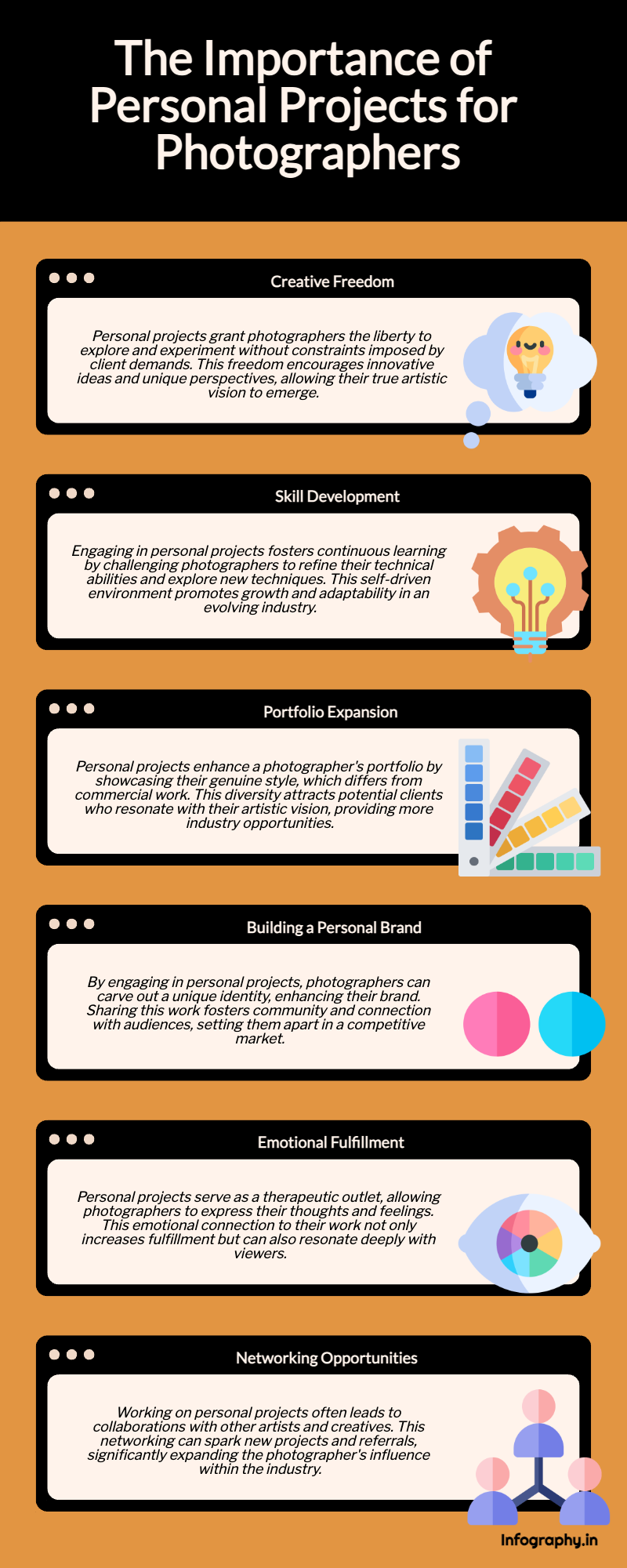PERSONAL PROJECTS
THIS PAGE GOES LIVE NOVEMBER 11, 2024
I believe in the importance of personal projects for photographers, and argue that they are essential for growth and development. I emphasize that personal projects offer photographers creative freedom, the opportunity to hone their skills, and a chance to build a distinctive brand. Personal projects can expand a photographer’s portfolio and attract potential clients, while also providing emotional fulfillment and networking opportunities. I include tips for developing and choosing a personal project, emphasizing the importance of reflecting on personal interests, identifying areas for growth, considering practicality, and challenging oneself.
The AI Created "Deep Dive" Podcase

Feel free to ask any questions.
This page will be updated monthly until March 2025.
The Power of Personal Projects
Personal projects give us something invaluable: freedom.
Freedom to dig deep into our artistic vision and follow instincts and ideas we might otherwise have to curb on commercial shoots. Here, we can test out the lighting, angles, or concepts that seem too bold or unconventional in a client’s eyes.
Not only will this sharpen skills, but it also creates a portfolio of work that represents our truest voice, our authentic voice—a collection that can make the difference when a brand or agency wants something distinctive, something beyond the cookie-cutter.
Cookie cutter is best handled by stock, or… (gulp) AI. And it surely will be. But authentic will be what is needed when they realize the stock stuff ain’t moving the needle.
These projects often act as a mirror, reflecting our growth and evolution as artists. They push us out of comfort zones, introduce new subjects, and may even surprise us with a whole new direction we hadn’t anticipated.
So, personal projects aren’t “passion projects”; they’re foundational to staying ahead, keeping creative hunger alive, and cultivating a style that’s both unmistakable and uniquely our own.
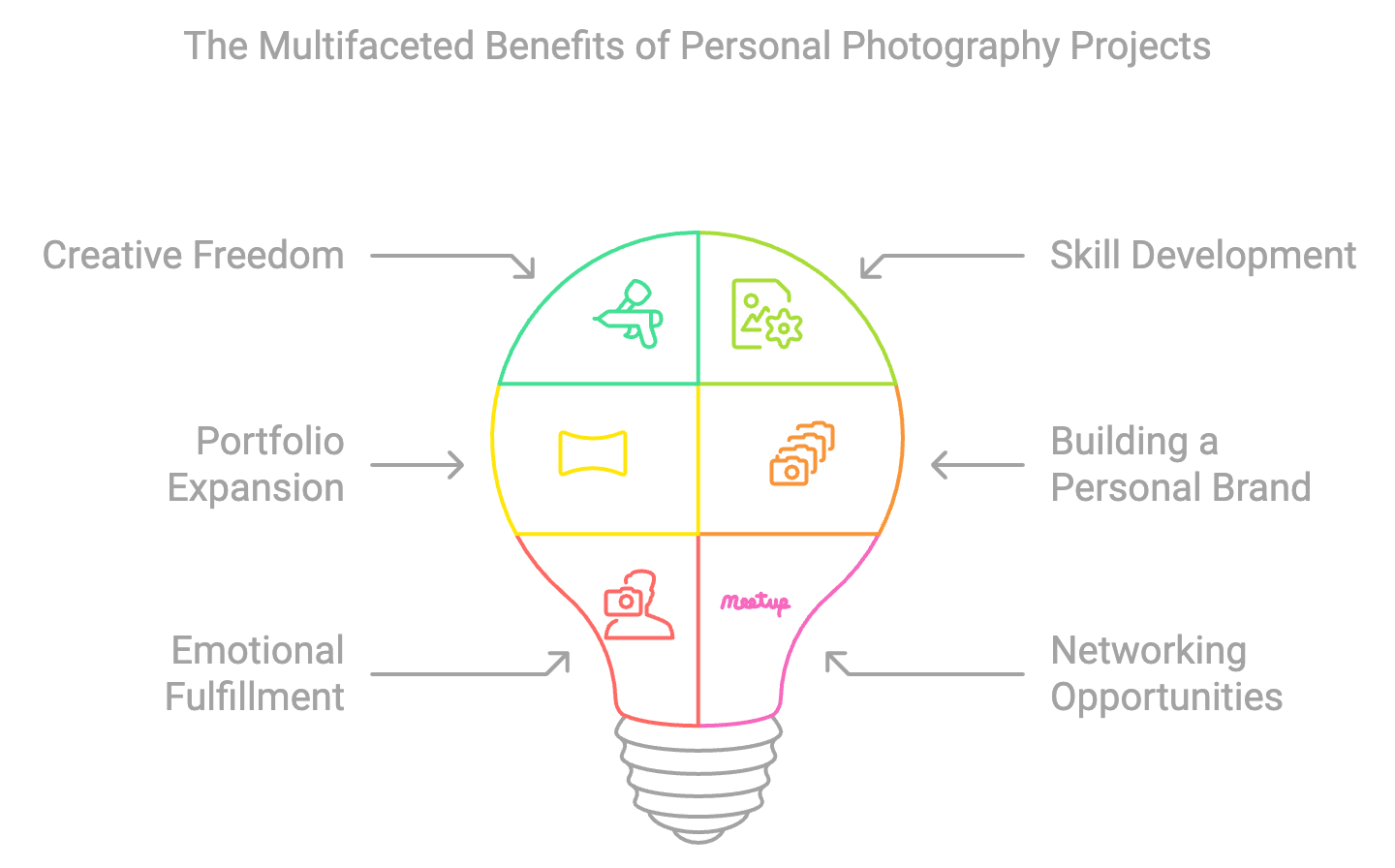
1. Creative Freedom
Personal projects provide photographers with the freedom to experiment with new techniques, styles, and subjects. Unlike commercial work, which often has specific guidelines and client expectations, personal projects allow photographers to pursue their interests and passions. This creative liberty can lead to innovative ideas and unique perspectives that may not emerge in a structured environment.
I used my GLOCAS project to have a bit of fun, and create a sandbox for play. GLOCAS = Girls Looking Off Camera At Stuff.
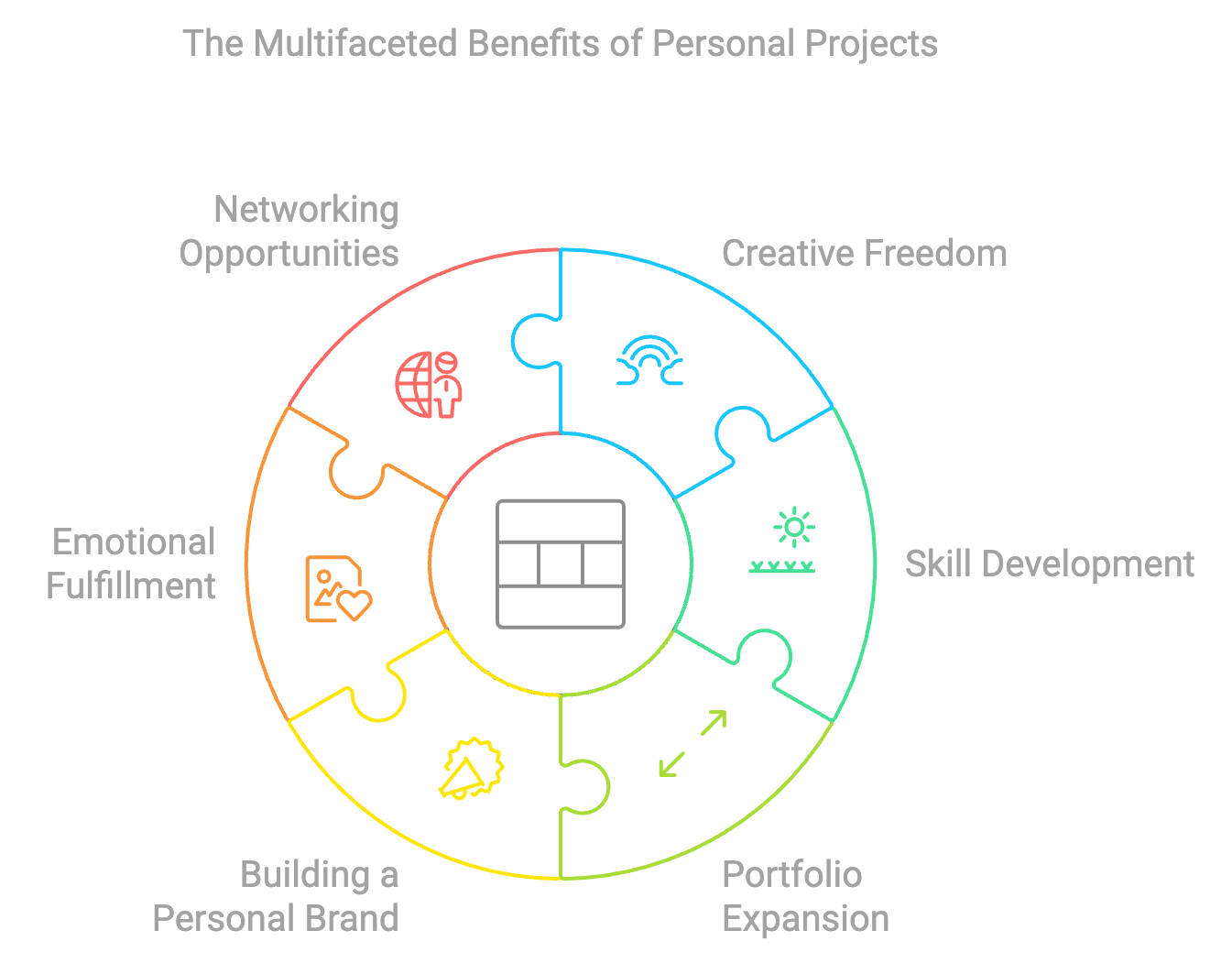
2. Skill Development
Engaging in personal projects is an excellent way for photographers to hone their skills. They can improve their technical abilities and artistic vision by challenging themselves with new concepts or techniques. Whether mastering a new camera setting, exploring different lighting conditions, or experimenting with post-processing techniques, personal projects encourage continuous learning and growth.
Jennifer Arce has been building her motion portfolio by trying different ideas.
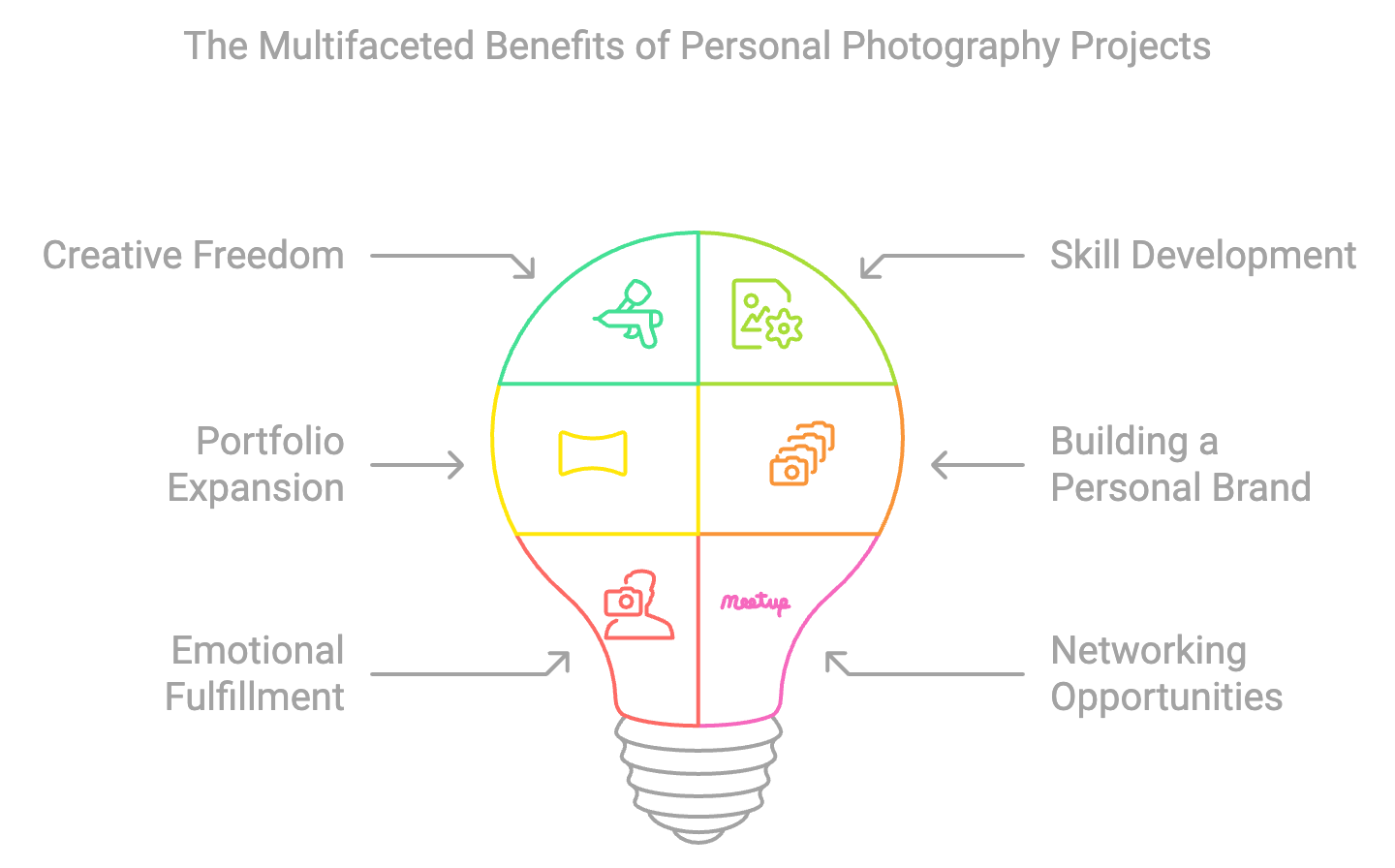
3. Portfolio Expansion
Personal projects can significantly enhance a photographer’s portfolio. They provide an opportunity to showcase work that reflects their true style and interests, which may differ from their commercial projects. A diverse portfolio that includes personal work can attract potential clients who resonate with the photographer’s artistic vision, ultimately leading to more opportunities in the industry.
Ligia Cuevas Johnson has turned personal projects into books.
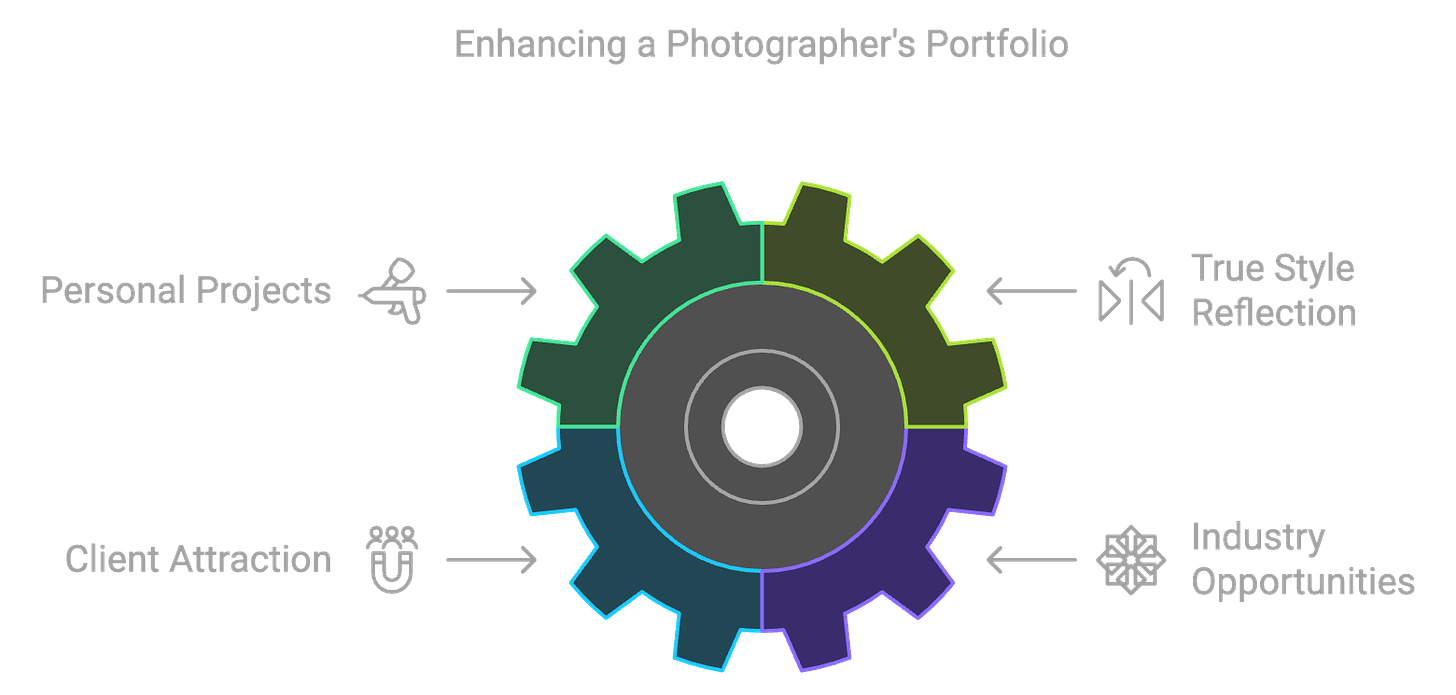
4. Building a Personal Brand
In a competitive market, establishing a strong personal brand is crucial for photographers. Personal projects allow photographers to define their unique voice and aesthetic, setting them apart from others in the field. By sharing their personal work on social media or photography platforms, they can engage with a broader audience and build a community around their artistic identity.
Upstate New York photographer, Larry Felton, has built a formidable portrait portfolio by working with real people around his town. It started as a project, and is now his forte.
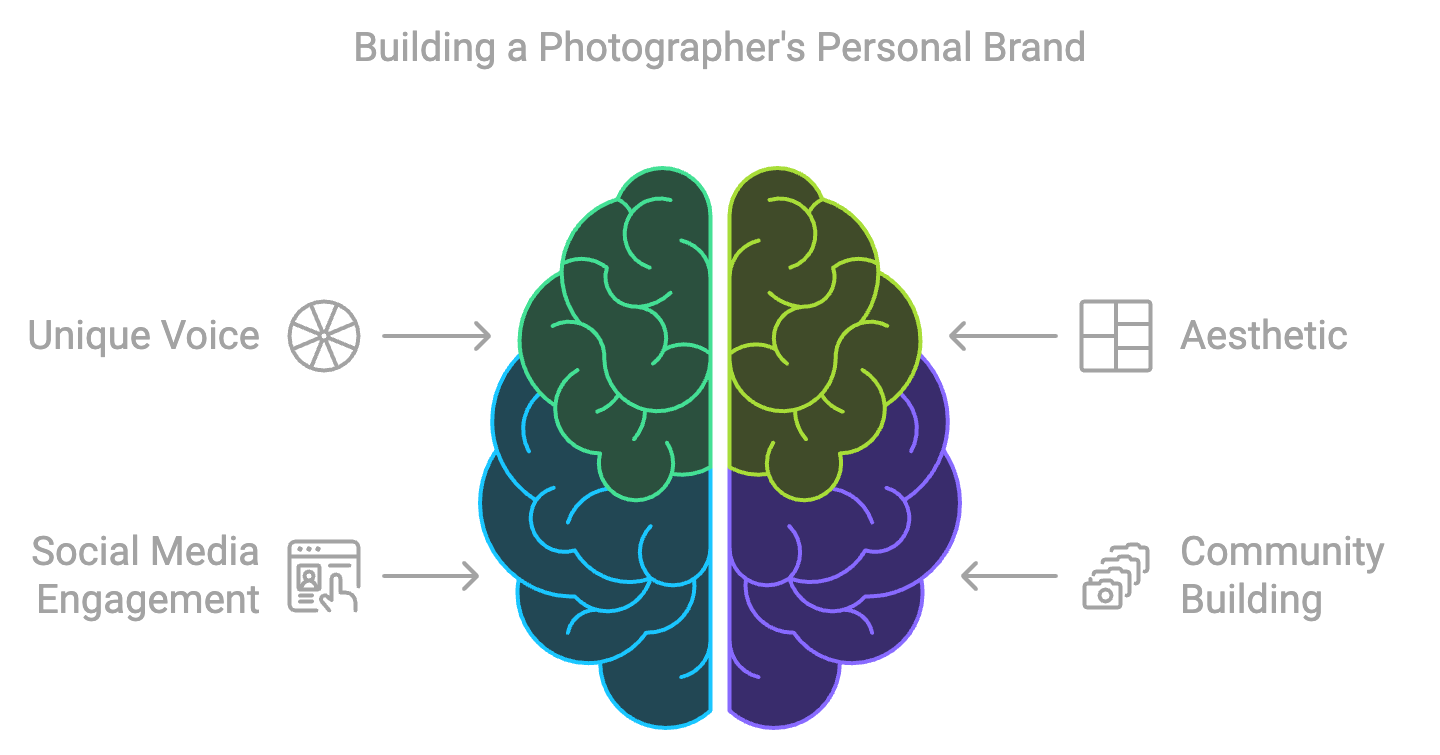
5. Emotional Fulfillment
Photography is not just a profession; it is also a form of self-expression and emotional release. Personal projects can serve as a therapeutic outlet, allowing photographers to explore their thoughts, feelings, and experiences through their lens. This emotional connection to their work can lead to greater satisfaction and fulfillment, making photography a more rewarding pursuit.
Alex Baker was examining some of the issues of motherhood when this project emerged.
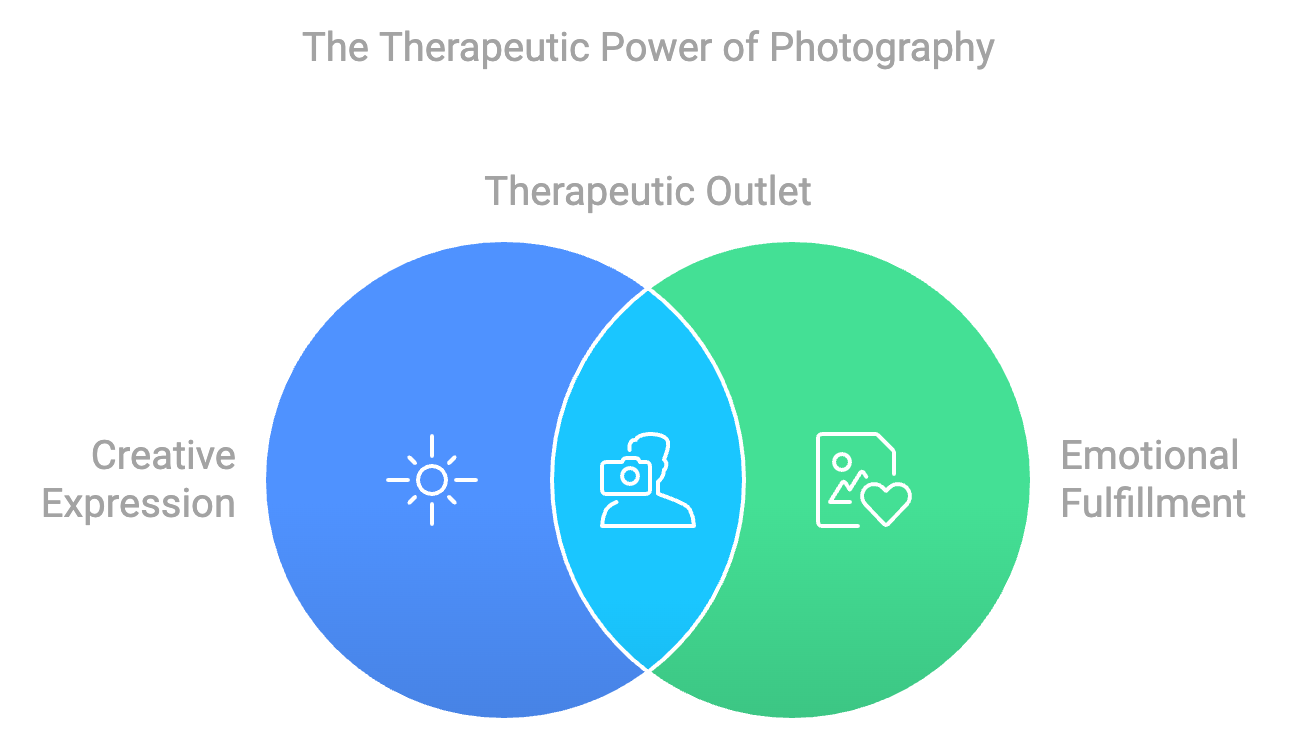
6. Networking Opportunities
Working on personal projects can open doors to new networking opportunities. Photographers can collaborate with other artists, models, or creatives, fostering relationships that may lead to future projects or referrals. Sharing personal work can also attract the attention of industry professionals, leading to potential partnerships or collaborations.
Carla McMahon decided to do a book on Gin Distilling. That led to a lot of introductions and many of those turned into clients.
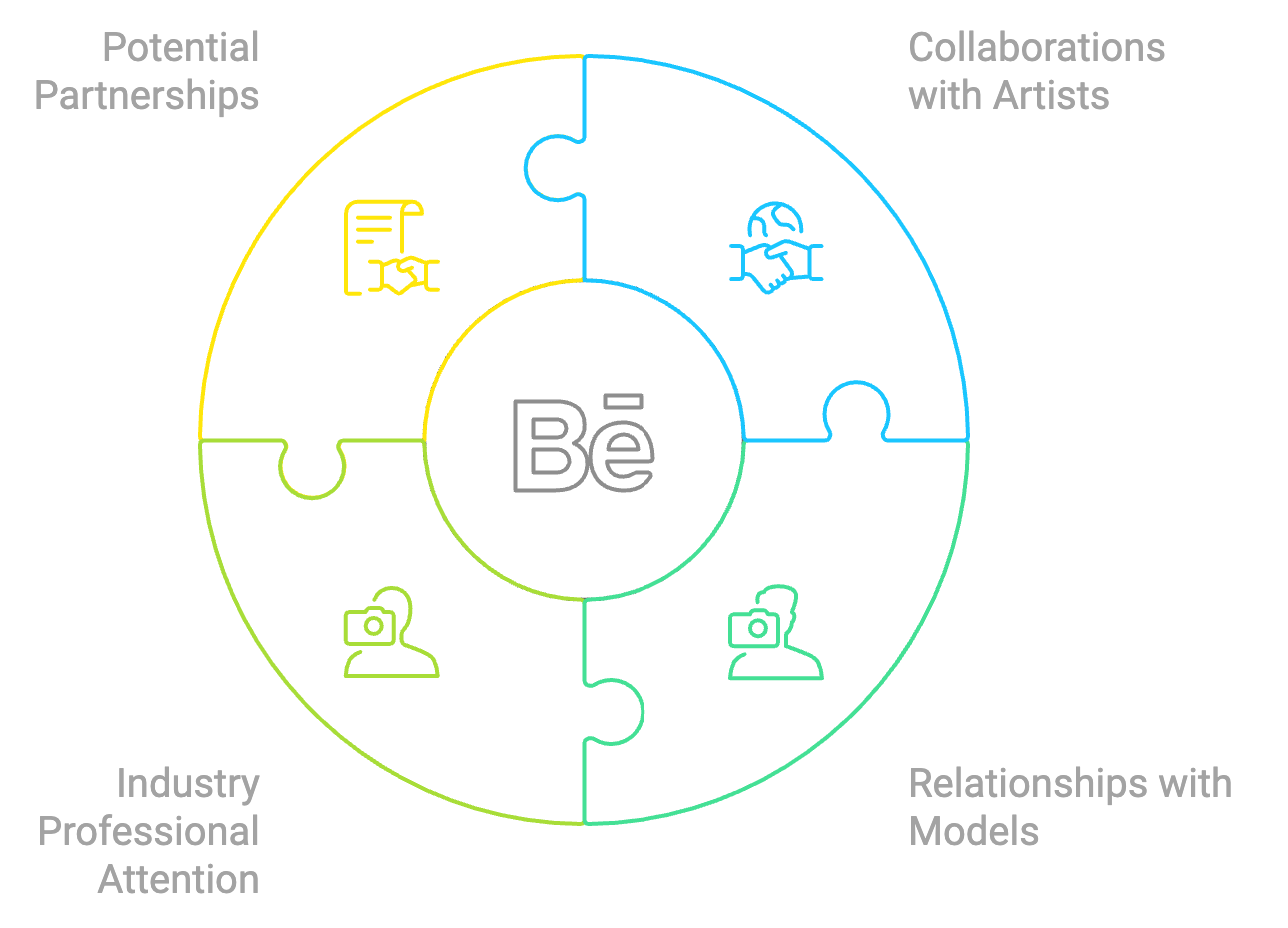
Should You Do a Personal Project?
Personal projects are an essential aspect of a photographer’s progressive journey. They provide creative freedom, facilitate skill development, enhance portfolios, build personal brands, offer emotional fulfillment, and create networking opportunities.
By dedicating time to personal projects, photographers can not only grow as artists but also find deeper meaning and joy in their craft.
Some ideas for personal projects
Deciding on a personal project as a photographer isn’t as simple as jumping on any random idea—though sometimes, an impulsive leap can bring a fresh spark. However, most photographers find that a mix of intuition and intention yields the best results.
Here’s a structured approach to help find that “just right” project that aligns with both your curiosity and creative goals.
How do we decide on a personal project?
1. Reflect on Personal Interests and Passions
Start by thinking about what truly excites you outside of photography. Maybe it’s travel, music, architecture, or stories from history. Passion often brings depth and persistence to a project, and audiences can sense the authenticity in the work.
Start: Make a list of three non-photography things you love or are deeply curious about. These may provide a thematic anchor for a meaningful project.
2. Identify Areas for Growth
Personal projects are ideal for experimenting with new techniques or refining skills that feel “rusty.” Think about what you want to master—maybe it’s lighting control, or posing, or macro photography, or maybe even post-processing. A project with a technical goal gives you a target to focus on and keeps the work purposeful.
Start: Ask yourself, “What’s one skill I wish I were better at?” Use the answer to shape the style or theme or goal of your project.
3. Consider Practicality and Feasibility
Balancing ambition with practicality is key. Consider factors like time, budget, and access to locations or subjects. Personal projects shouldn’t be a source of stress—they’re meant to inspire. A project that’s possible within your available resources can still be incredibly impactful. it’s what you do with it that matters the most.
Start: If a project idea seems too big, break it down. Find a way to start with a “mini-project” that allows you to test the waters without a massive commitment.
4. Challenge Yourself to Step Outside Your Comfort Zone
Personal projects are a chance to explore unfamiliar territory, which often leads to surprising growth. Choosing something that stretches your current abilities or subjects you’re not entirely comfortable with can push your creative boundaries.
Start: Reflect on past shoots that made you nervous or uncomfortable. Was it directing people? Trying extreme lighting? Consider a project that tackles this head-on. This can open more creative ideas for you while gaining practical skills.
5. Think About What You Want to Say with Your Work
Photography is a powerful storytelling medium. Ask yourself if there’s something you want to convey—a feeling, a commentary, or an exploration of a theme that resonates with you. Projects with an emotional or conceptual backbone tend to have a deeper impact. Perhaps your story can be helpful to a community that needs it.
Start: If you could tell a stranger one thing about the world through your photography, what would it be? Use that answer as a compass for your project’s direction.
But… Should You Think It All Through or Just Do It?
If an idea strikes that you feel passionately drawn to, give yourself permission to jump in without overthinking it. Let the project evolve organically—you can always adjust as you go. As of this writing, you can still follow your heart in this stuff.
However, a little planning can be a game-changer for more elaborate projects. When a project is complex or resource-intensive, some pre-planning around logistics, timeline, and objectives can make it sustainable.
For instance. I have seen a personal project that was shot in a very short amount of time;
Scott Montgomery
Robin O’Neill
And some projects expand over time, some even using time as part of the project.
Lars Schneider
Beth Galton
Ultimately, it’s a balance: let your gut point you toward an idea that resonates, then give it just enough structure so it doesn’t fizzle out. And remember—personal projects aren’t about perfection; they’re about exploration, growth, and creative play. Whether it’s a meticulously planned endeavor or a spur-of-the-moment pursuit, a good project feels personal, nearly obsessive, and ultimately keeps you excited.
- Why They Are Essential
- Commercial's Unique Approach
- Creative Aspects
- Key Elements
- Practical Considerations
Personal projects are essential for photographers in a competitive market for several reasons:
- They allow photographers to develop a unique style and stand out from the crowd. In a market saturated with talented photographers, having a distinctive style is crucial for attracting clients and building a successful career. Personal projects provide the freedom to experiment and explore different aesthetics without the constraints of client briefs, allowing photographers to hone their unique vision and create a portfolio that showcases their individual voice.
- They offer opportunities for skill development and creative growth. Personal projects encourage photographers to step outside their comfort zones and try new techniques, lighting styles, post-processing methods, or subject matter. This continuous learning and experimentation help them expand their skillset and stay ahead of the curve in a constantly evolving industry. [5-10] The sources highlight the importance of using personal projects as a “playground for experimentation” to push boundaries and explore fresh narratives.
- They help build a strong personal brand. Personal projects allow photographers to showcase work that aligns with their passions and interests, helping them attract clients who resonate with their artistic vision. By consistently creating and sharing personal work, photographers can establish a recognizable brand identity and cultivate a loyal following.
- They provide a platform for self-expression and emotional connection. Photography is a powerful medium for storytelling and conveying emotions. Personal projects allow photographers to explore themes that are personally meaningful to them, fostering a deeper connection to their work and potentially resonating with viewers on an emotional level. This authenticity and emotional depth can be a powerful differentiator in a market often driven by commercial considerations.
- They can lead to new opportunities and collaborations. Sharing personal projects can attract the attention of potential clients, collaborators, or industry professionals. These connections can open doors to new assignments, partnerships, or exhibitions, further expanding the photographer’s reach and influence within the industry.
In essence, personal projects are not just a creative outlet for photographers; they are a strategic investment in their careers, enabling them to cultivate a distinct style, refine their skills, build a recognizable brand, connect with their audience, and unlock new opportunities in a competitive market.
Here is a comprehensive look at how personal projects differ from commercial photography, based on the sources provided.
Creative Freedom and Control
- Personal projects offer photographers complete creative freedom to experiment with new techniques, styles, and subjects. They can pursue their own interests and passions without being restricted by client expectations or guidelines. In commercial photography, the client’s needs and vision drive the project.
- This creative liberty in personal projects can lead to innovative ideas and unique perspectives that might not emerge in a more structured commercial environment.
- The sources emphasize that personal projects are a “playground for experimentation,” allowing photographers to stretch their boundaries and explore fresh narratives. They offer a space to test lighting, angles, or concepts that might be considered too bold or unconventional for a commercial client.
Goals and Objectives
- Personal projects are driven by the photographer’s personal goals, whether it’s skill development, exploring a particular theme, or expressing their artistic vision. Commercial photography, on the other hand, is primarily focused on meeting the client’s objectives and delivering images that fulfill the brief.
- The sources highlight that personal projects can help photographers enhance their portfolio by showcasing work that reflects their true style and interests. This diverse portfolio can attract potential clients who connect with the photographer’s artistic vision.
- Personal projects can also play a vital role in building a strong personal brand. [6, 7] In a competitive market, having a unique voice and aesthetic sets photographers apart.
Emotional Connection and Fulfillment
- Personal projects allow photographers to tap into their emotions and explore their thoughts, feelings, and experiences through their lens. This deep connection to their work can lead to greater satisfaction and fulfillment.
- Commercial photography, while creatively fulfilling, can sometimes lack this level of personal connection as the focus is on fulfilling the client’s vision rather than the photographer’s own.
Impact and Reach
- While personal projects can lead to networking opportunities and even commercial work, their primary purpose is not necessarily financial gain or widespread recognition. The focus is on personal growth and artistic expression.
- Commercial photography, on the other hand, is often driven by commercial objectives, such as advertising a product or service, and aims to reach a specific target audience.
In essence, personal projects are a form of artistic exploration and self-discovery for photographers, allowing them to hone their skills, express their unique vision, and connect with their audience on a deeper level. Commercial photography, while offering its own creative challenges and rewards, is primarily driven by client needs and commercial objectives.
Personal projects offer photographers creative freedom, allowing them to experiment with new techniques and styles outside of client expectations [1, 2]. This can lead to skill development, as photographers can challenge themselves with new concepts or techniques like mastering camera settings, exploring lighting conditions, or experimenting with post-processing techniques.
Personal projects also allow photographers to build a strong brand. By showcasing work that reflects their true style and interests, photographers can attract clients who resonate with their artistic vision. This is especially important in a competitive market where establishing a unique voice and aesthetic is crucial [5, 6]. Sharing personal work on social media or photography platforms can further enhance brand building by engaging a broader audience and building a community around the photographer’s artistic identity.
Finally, personal projects can help photographers connect with their audience on an emotional level. Photography can be a form of self-expression and emotional release, and personal projects allow photographers to explore their thoughts, feelings, and experiences through their lens . This emotional connection can lead to greater satisfaction and fulfillment for the photographer, making photography a more rewarding pursuit. Sharing these personal projects can resonate with viewers, forging a connection through shared experiences or perspectives.
For example, Alex Baker’s project examined the issues of motherhood [7], which could potentially connect with an audience of mothers who have experienced similar challenges. Additionally, personal projects can create networking opportunities, allowing photographers to collaborate with other artists and creatives, potentially leading to future projects, referrals, or partnerships. Building these relationships within the creative community can indirectly help photographers connect with a wider audience.
Personal projects can help photographers develop their unique style and artistic voice by providing them creative freedom to experiment with new techniques, styles, and subjects without client expectations. [1-5] This freedom allows photographers to explore their interests and passions, leading to innovative ideas and unique perspectives. [2, 5] Personal projects also act as a mirror, reflecting their growth and evolution as artists by pushing them out of their comfort zones. [1, 4] Through this exploration, photographers can cultivate a style that is both unmistakable and uniquely their own.
Here are some ways in which personal projects help photographers develop their unique style and artistic voice:
- Skill development: Personal projects offer photographers opportunities to hone their skills and improve their technical abilities and artistic vision by challenging themselves with new concepts or techniques.
- Building a personal brand: Personal projects allow photographers to define their unique voice and aesthetic, setting them apart from others in the field. By sharing their personal work, they can attract potential clients who resonate with their artistic vision.
- Emotional fulfillment: Photography can be a form of self-expression and emotional release. Through personal projects, photographers can explore their thoughts, feelings, and experiences, leading to greater satisfaction and fulfillment in their work.
The sources highlight examples of photographers who have successfully used personal projects to develop their style and artistic voice:
- Larry Felton built a formidable portrait portfolio by working with real people in his town.
- Alex Baker explored the issues of motherhood through a personal project.
Ultimately, personal projects are about exploration, growth, and creative play, allowing photographers to develop a style that is personal, nearly obsessive, and keeps them excited about their craft.
Here are some practical considerations when deciding on a personal photography project, based on the sources you provided:
- Time Commitment: Consider how much time you can realistically dedicate to your project. Some projects might be short-term and intensive, while others could span months or even years. Evaluate your schedule and commitments to determine a timeframe that allows for consistent progress without becoming overwhelming. For instance, Scott Montgomery and Robin O’Neill completed a personal project in a short amount of time while Lars Schneider and Beth Galton worked on projects over a longer period, sometimes incorporating time as a key element.
- Budget: Think about the financial resources you have available for your project. Some projects may require travel, specialized equipment, props, model fees, or other expenses. Determine a budget that aligns with your financial situation and explore creative solutions to minimize costs where possible.
- Accessibility of Locations and Subjects: If your project involves specific locations or subjects, ensure you have access to them. Research permits, permissions, and travel logistics beforehand to avoid potential roadblocks. Consider alternative options or adaptations if certain locations or subjects prove challenging to access.
- Scope and Complexity: Be realistic about the scale and complexity of your project. A smaller, more manageable project might be a better starting point, especially if you’re new to personal projects. You can always expand upon your initial concept later. Breaking down a larger project into smaller, achievable phases can make it more manageable and less daunting.
- Equipment and Resources: Evaluate the equipment and resources you need to execute your vision. Do you need to invest in new lenses, lighting, or software? Can you borrow or rent equipment? Consider the technical requirements of your project and plan accordingly.
- Sustainability and Motivation: Choose a project that genuinely excites you and aligns with your passions. Personal projects should be a source of creative fulfillment, not a chore. Select a theme or subject that will sustain your interest over time and motivate you to push through challenges.
- Planning and Structure: While personal projects encourage creative exploration, some level of planning can be beneficial. Outline your goals, define a rough timeline, and consider logistical aspects to ensure a smooth workflow. However, don’t overthink it to the point of stifling spontaneity and creative flow. Striking a balance between planning and improvisation is key.
Remember, personal projects are an opportunity for growth and self-discovery. Embrace the process, experiment, and allow yourself to learn and evolve along the way. The most successful projects are those that genuinely resonate with you and push you to explore new creative territories.
How to Find and Prepare for Your Next Personal Photography Project
How to Find and Prepare for Your Next Personal Photography Project
So, you’re ready to start a personal project but aren’t sure where to begin. Maybe you’re stuck in a creative rut, or maybe you have so many ideas that you can’t choose just one. Whatever the case, getting a solid project idea doesn’t have to be complicated. Here’s a guide to help you tap into your interests, identify meaningful themes, and set yourself up for success.
1. Reflect on Your Passions and Interests
The best personal projects often stem from things you’re genuinely curious about or passionate about. Think about the subjects that captivate you outside of photography. It could be music, history, people, or even a place you visit regularly. This is about finding something you’ll want to dive into, not just for the photos but for the experience itself.
Ask Yourself:
- What topics do I love to explore in my free time?
- Is there something I could photograph repeatedly without getting bored?
- What have I always wanted to learn more about?
Example: If you’re fascinated by urban architecture, consider a project documenting your city’s hidden architectural gems or the stories behind them.
2. Identify Skills You Want to Develop
Personal projects are the perfect playground to sharpen skills. Maybe you’ve been itching to experiment with low-light photography or want to learn more about capturing motion. By choosing a project that centers around a technique or skill, you’ll create an opportunity to practice consistently, without the stress of client expectations.
Ask Yourself:
- What technical skill am I looking to improve?
- Is there a photography style I admire that I haven’t tried?
- What type of shoot intimidates me (in a good way)?
Example: If you want to improve your portrait lighting, create a project around environmental portraits of people in their natural workspaces—this could range from chefs in kitchens to artists in studios.
3. Explore Themes That Resonate with You Emotionally
Photography is an expressive art, and personal projects are a chance to explore themes that have personal meaning. Think about events, people, or experiences that have had a significant impact on you. These types of projects often yield work that’s not only visually compelling but deeply meaningful to you—and to others.
Ask Yourself:
- What stories do I want to tell?
- Is there a social or personal issue I’d like to highlight?
- Do I have a unique perspective on something I’d like to share?
Example: If you’ve dealt with a specific life challenge, like moving to a new country, you could create a series capturing the lives of others in similar transitions, revealing shared experiences and differences.
4. Consider Practical Constraints
Sometimes the best projects are those that fit seamlessly into your daily routine. This doesn’t mean they can’t be ambitious, but keeping logistics in mind can make it easier to sustain the project. Look at your schedule, resources, and any limitations. If your time is limited, choose something close to home or something you can work on in short bursts.
Ask Yourself:
- How much time can I realistically dedicate to this project?
- Do I need special equipment, permits, or access to locations?
- Could I start with a smaller version of the idea?
Example: If you’re strapped for time, consider a “365 project” where you capture one small moment each day. These daily shots can lead to surprising, cohesive work by the end of the year.
5. Challenge Yourself to Step Outside Your Comfort Zone
The magic of personal projects often lies in trying something you wouldn’t typically do. This might mean experimenting with a new genre, shooting in a different environment, or even photographing people if you usually stick to landscapes. Personal projects are a low-risk way to try out new things, so take advantage of the freedom to fail and learn.
Ask Yourself:
- What types of projects scare me or feel uncomfortable?
- What’s one aspect of photography I avoid or think isn’t “my style”?
- How can I push my creative boundaries with this project?
Example: If you’re a product photographer, try your hand at street photography for a change of pace. You’ll develop a new skill set and could bring fresh ideas back to your usual work.
6. Think About the End Goal or Purpose
While the process of creating is important, it can help to know where you want the project to end up. Do you want to publish it online, turn it into a book, or even pitch it to a gallery? Knowing your end goal can shape your approach and help you stay motivated. Plus, having a clear direction for where you’ll showcase your work can lend the project extra significance.
Ask Yourself:
- Do I want this project to be seen by others, or is it just for me?
- Where could I share this project to maximize its impact?
- How will I feel once this project is complete?
Example: If your goal is to get published, consider themes that might resonate with specific publications or magazines. This can give your project a clearer direction and make it easier to edit and finalize.
7. Start Small but Stay Consistent
Once you’ve found an idea that excites you, don’t wait for perfect conditions. Start small and commit to working on it regularly. Whether it’s a single shoot per week or even one photo per day, consistent effort is what builds momentum. Many personal projects begin as something small and grow organically—so don’t pressure yourself to have everything mapped out from the start.
Practical Tip: Set a schedule, even if it’s flexible. Having dedicated time blocked off for your project each week can help you build a routine and maintain momentum.
Build in Public, or Keep It Under Wraps
Sharing a project as it develops can be a fantastic way to build engagement, but it depends on your goals and personal style. Let’s look at the benefits of each approach:
1. Building in Public (Sharing the Process)
This approach can be very engaging, especially on platforms like Instagram, YouTube, or even a personal blog. Here’s why it works:
- Connection: Sharing your progress invites your audience to take the journey with you. They get invested in the project’s story, and their support can be motivating.
- Feedback Loop: Early feedback can help you refine or pivot aspects of the project. You might gain insights or even ideas that push the project further.
- Building Anticipation: By showing behind-the-scenes or early-stage work, you’re building anticipation for the final product, creating a sense of “you won’t want to miss this!”
How to Do It: Share snapshots, concepts, or challenges you’re encountering, and add a bit of context. Talk about the “why” behind certain decisions or what you’re learning. This makes each post part of a broader story, not just a single image.
2. Saving for the Big Reveal (Sharing Only the Finished Project)
Keeping the project under wraps until it’s polished can have its own powerful impact:
- Strong First Impression: When you finally unveil it, the impact can be more cohesive and refined. This is especially effective if you want the final piece to make a big statement.
- Complete Control: You have full control over the narrative without external influence. This allows you to take creative risks privately and tweak things until they’re just right.
- More Versatile for Portfolio/Exhibits: If you’re aiming for portfolio or exhibition use, saving it for a polished release often ensures it aligns with your brand or aesthetic vision.
How to Do It: When you’re ready to reveal, launch it as a full project with a clear narrative or backstory. You can introduce it as a cohesive body of work and may even consider showcasing it as a series in a dedicated post, video, or blog entry.
Hybrid Approach
Many photographers find a hybrid approach effective. Share teasers or snippets of the process without giving too much away. This keeps interest alive but saves the main reveal for later.
Ultimately, it’s about what feels right for you and your audience. If you’re comfortable letting people see the journey, building in public can add a personal touch. If you prefer to create quietly, the reveal will have its own kind of impact. Either way, your story will connect!
Planning A Project
Preparing for a personal project with a dedicated notebook or organized system can make a big difference in keeping things on track, especially with time and resources at stake. Here’s a practical way to set up a project notebook, covering both online and paper options, and key items to track.
1. Choosing Your Format: Online vs. Paper
Both online and paper formats have their strengths, so consider your workflow:
-
Online (Digital): Tools like Notion, Evernote, or even a dedicated Google Doc or Sheets allow for easy access and flexibility. Digital notes are great if you want to incorporate multimedia, like quick photo uploads, reference images, or links. Plus, it’s easier to organize and rearrange sections as you go.
-
Paper (Analog): A physical notebook adds a tactile experience, which can feel more personal and is easy to access without screens. If you like to sketch ideas, jot notes quickly, or stick in physical inspirations (like magazine clippings or fabric samples), a paper notebook is ideal.
Tip: Some photographers do a combination—paper for quick sketches or initial brainstorming, and digital for ongoing updates and tracking.
2. Key Sections to Include in Your Project Notebook
1. Project Overview & Vision
- Purpose: Write down your main goal for the project—what do you want to accomplish or communicate? Include your “why” here.
- Theme or Concept: Define the central theme. Include any initial thoughts, feelings, or ideas that sparked the project.
- Inspirations & Mood: Collect reference images, quotes, or color schemes that inspire you. If online, you could link to Pinterest boards, saved Instagram posts, or articles.
2. Resources & Budget
- Equipment Needed: List out gear, props, or tools you might need. Note any rentals or purchases you’ll need to plan for.
- Budget Tracking: Include a section to track costs, such as equipment rentals, travel expenses, or printing costs. Having a budget keeps you realistic and can help you plan for unexpected expenses.
- Time Investment: Estimate how much time each part of the project will take and build a rough schedule. This can help you balance the project with other commitments.
3. Planning & Logistics
- Location Scouting: For projects that involve specific settings, include location ideas, scouting notes, and any permit requirements.
- Scheduling & Timeline: A timeline helps keep the project manageable. Break down each phase (planning, shooting, editing, etc.), so you have a clear path forward.
- People & Collaborators: If you’re working with models, stylists, or other creatives, keep their contact info and schedule here. If you’re handling the project solo, still outline what tasks you’ll need to manage.
4. Concept Development
- Shot List or Storyboard: For more structured projects, create a shot list or storyboard. Even a rough list of must-have shots will help keep the sessions focused.
- Lighting & Setup Notes: This is great if you’re experimenting with new techniques. Record your setups, especially if you want to refine or replicate them.
- Styling or Props: If your project requires specific styling, sketch out or note details for outfits, props, or scenes.
5. Progress Journal
- Weekly or Session Notes: Track your thoughts and progress after each work session. Document what worked, what didn’t, and any ideas for improvement.
- Challenges & Solutions: Note any obstacles you encounter and how you overcome them. This becomes a helpful resource if you need to problem-solve later.
- Adjustments & Refinements: Personal projects are fluid, and ideas often evolve. Keep notes on any adjustments to the original concept as you go.
6. Marketing & Promotion Plan (Optional)
- Social Media Strategy: If you plan to share along the way, note down any specific shots or stories you want to highlight for social media.
- Launch & Publishing: If you’re saving the reveal for a single release, outline where and how you want to launch it. Consider platforms (Instagram, website, portfolio sites) and any relevant hashtags or tags.
7. Reflection & Takeaways
- Project Evaluation: Once the project is complete, jot down a summary of what you learned, what surprised you, and what you’d do differently.
- Next Steps: Sometimes a personal project evolves into something bigger. Note any follow-up ideas or ways to expand on this project.
Ten Project Ideas for Ideation
Here are ten personal photography project ideas that can be completed within a month or two, each offering unique ways to explore different aspects of photography, storytelling, and creativity.
1. “Strangers in Their Element” Portrait Series
- Concept: Capture portraits of strangers in their everyday environments—baristas in coffee shops, musicians at local venues, shopkeepers in their stores.
- Goal: Practice environmental portraiture, connecting people’s personalities with their surroundings.
- Challenge: Approach people in public and capture them authentically.
2. “Color of the Day” Challenge
- Concept: Choose one color to focus on each day or week and photograph objects, scenes, or outfits in that color.
- Goal: Enhance your awareness of color theory and composition.
- Challenge: Try not to repeat subjects or locations, pushing yourself to find new elements each time.
3. Urban Minimalism
- Concept: Capture clean, minimalist images of architecture or urban landscapes, focusing on negative space and symmetry.
- Goal: Develop a minimalist aesthetic and experiment with shapes, lines, and patterns in urban settings.
- Challenge: Limit yourself to two or three colors and simple compositions for a cohesive look.
4. 365-Second Project (One-Second Videos for a Month)
- Concept: Record one-second video clips each day to create a 30-second montage at the end of the month.
- Goal: Build a short, daily ritual of capturing moments without overthinking, perfect for learning video storytelling.
- Challenge: Capture clips that tell a story, from sunrise to sunset, to create a meaningful sequence.
5. “Weather Diaries” Landscape Study
- Concept: Document the changing weather in your area, from sunny mornings to stormy evenings.
- Goal: Practice landscape and weather photography, highlighting how light and atmosphere transform familiar places.
- Challenge: Aim to shoot at the same location or angle each day for a sense of continuity and comparison.
6. Self-Portrait Series with a Twist
- Concept: Take a daily self-portrait but incorporate an element of disguise or props that alter the mood or character each time.
- Goal: Develop your creative self-portraiture skills and play with lighting, composition, and character building.
- Challenge: Avoid repeating ideas. Each portrait should feel like a new character or story.
7. Textures of Nature Macro Project
- Concept: Focus on photographing the intricate textures of natural elements like leaves, rocks, sand, bark, and water.
- Goal: Improve your macro photography skills and explore abstract compositions within nature.
- Challenge: Use natural light only and avoid post-processing for an organic look.
8. Street Reflections and Shadows
- Concept: Capture reflections and shadows in urban settings, like reflections in puddles, glass buildings, or shadows cast by trees.
- Goal: Develop a keen eye for composition, especially with unconventional elements like reflections and silhouettes.
- Challenge: Find reflections and shadows that form interesting shapes or highlight contrasts between light and dark.
9. “Faces of the Neighborhood” Documentary Project
- Concept: Capture portraits or candid shots of people in your neighborhood, from shop owners to neighbors walking their dogs.
- Goal: Build your documentary photography skills and create a visual story of a community.
- Challenge: Try to build rapport with each subject and tell a little about their story in each shot.
10. Abandoned Spaces or Forgotten Places
- Concept: Document abandoned buildings, deserted parks, or forgotten corners of your city to capture a sense of mystery or nostalgia.
- Goal: Work on creating atmosphere and mood within your shots, using light, composition, and post-processing.
- Challenge: Take time to capture these spaces thoughtfully and look for details that show their history or neglect.
Each of these ideas is designed to help you stretch your skills, try new techniques, and create a unique body of work that you can complete in a short timeframe. Whether you want to experiment with color, practice portraiture, or capture natural textures, these projects will keep you inspired and productive!

